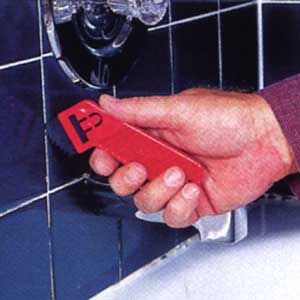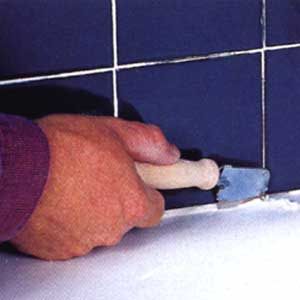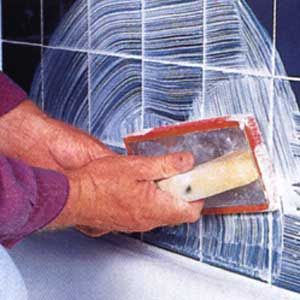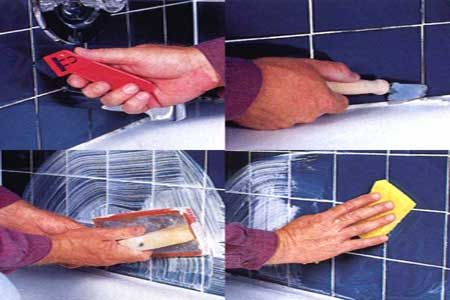We may be compensated if you purchase through links on our website. Our team is committed to delivering honest, objective, and independent reviews on home products and services.
Glazed ceramic tile is an ideal material for tub and shower walls. It’s impervious to moisture, easy to clean, and durable enough to withstand a lifetime of hot, sudsy soaking.
However, tile isn’t maintenance-free. A tiled wall is only as strong as the thin grout joints between the tiles. Once the grout starts to soften and crack, it’s only a matter of time before water seeps in and damages the mortar and drywall behind the tile.
Don’t wait for an entire wall of grout to fall out before taking action. The best way to avoid major wall repair is to regrout any joint when the first crack or stain appears. Repairing grout is also easy and inexpensive.
The four main steps of the tile repair are:
- Regrouting the tile
- Recaulking between the tub and tile
- Caulking around the shower handle and tub spout
- Protecting the grout joints with silicone sealer
We’ll walk through each stage of the project, step by step.
Tools and Materials You’ll Need To Restore a Tiled Wall
Restoring a tiled wall requires only a few hours of work and less than $75 in tools and materials. All prices below are approximate, based on our research at big-box home improvement stores.
- Grout saw: $10
- Straight blade scraper: $10
- Premixed or powdered grout: $15
- Rubber float: $8
- Silicone caulk: $8
- Silicone sealant: $8
Prepping for the Tile Restoration Project
The first phase of the tile restoration process is removing all the old grout and caulk that you’ll be replacing. Here’s how to do it.
Removing Old Grout
The first step is to clean out the damaged joints with a grout saw (available at most hardware stores). The saw’s plastic handle is fitted with a steel blade that has either sharp serrated teeth or an abrasive carbide grit.
Draw the blade along the joint to scratch out the old grout (photo below). Press firmly on the tool, but be sure it doesn’t pop out of the seam and mar the tile.

It usually takes only two or three passes to reach clean, sound grout beneath, though you may have to remove the entire section. In either case, cut the joint slightly beyond the damaged area and into healthy grout to be sure you removed all the old stuff.
Removing Old Caulk
Next, you’ll move on to removing the old caulk. It’s a similar process.
Use a straight-blade scraper to cut the caulk bead from between the top edge of the tub or shower pan and the first course of tile (photo below). Pull out as much of the old caulk as possible.
If necessary, use a putty knife or thin-blade screwdriver to extricate any stubborn blobs. Then clean the joint thoroughly to remove any remaining debris, grime, or soap buildup.

How To Regrout Tile
With the old grout removed, you’re ready to put new grout between your tiles.
Two types of grout are commonly available: premixed and powdered. Premixed grout works well for small repairs. For large jobs, buy a 5-pound carton of powdered grout and a quart of liquid latex additive. This make-it-yourself approach is more cost-effective and allows you to mix up fresh batches of grout as you need it. Follow the instructions on the powdered grout to mix it properly.
Once your grout is ready, simply scoop it out of its container and press it into the seams between tiles with your finger. Then proceed as follows:

- Use a rubber float to force the grout into the joints (photo above). Push the float diagonally across the tile and be sure not to miss any spots.
- Wait about five minutes.
- Use a clean, damp sponge to wipe the excess grout from the tile (photo above, right). Rinse the sponge frequently in clean water and continue wiping until only a light haze remains.
- Allow the grout to set overnight.
- Buff off the haze with a soft, dry cotton cloth.
How to Recaulk Tile
We recommend a 100% silicone caulk although it isn’t the easiest caulk to use. It skins over quickly and isn’t easy to smooth out, but it grips with bulldog tenacity and is very flexible. What’s more, it won’t tear free from the surface as latex caulk often does, nor will it crack like grout.
To make recaulking less arduous, buy a small squeeze tube of silicone. It’s much easier to control than a cartridge in a caulking gun. To properly caulk between the tile and tub, follow these steps:
- Cut the tip of the caulk tube at a 30-degree angle, making sure the opening is as wide as the joint.
- Squeeze the caulk into the joint (photo below, left), but be careful not to overfill it. Apply 10 to 12 inches of caulk at a time, and only enough to bring the joint out flush with the tile.
- Quickly smooth the bead with the tip of your finger before a skin forms over the surface.
- Squeeze in another short bead and repeat the process.
Don’t forget to caulk around the shower handle and tub spout, as well. To do so:
- Remove the shower handle by prying off the decorative cover with a thin-blade screwdriver.
- Back out the retaining screw and pull off the handle.
- Remove the trim plate and apply a continuous bead of silicone caulk around its rubber gasket.
- Press the plate back into position and replace the handle.
- Apply a thin bead of caulk all the way around the tub spout (photo below, right).
Don’t use the shower for two to three days so the grout and caulk can cure. If you must use the shower you just worked on, tape up plastic sheets to keep the walls dry.
How To Seal Grout Joints
Once everything has cured, apply a liquid silicone sealer to all the old and new grout joints. The sealer will make the grout more water-resistant and less porous, so it lasts longer and stays cleaner.
Daily Maintenance Tips for Your Ceramic Tile
To keep your ceramic tile looking its best between major maintenance periods, follow these daily care tips:
- Use a squeegee or towel to remove excess water from tile surfaces.
- Keep the bathroom well-ventilated to reduce moisture and prevent mold growth.
- Clean tiles regularly with a pH-neutral cleaner designed for ceramic surfaces.
- Avoid using abrasive cleaners or scrubbers that could damage the tile or grout.
Occasionally inspect grout lines for any signs of deterioration. Early detection of issues can prevent more significant issues down the road.

